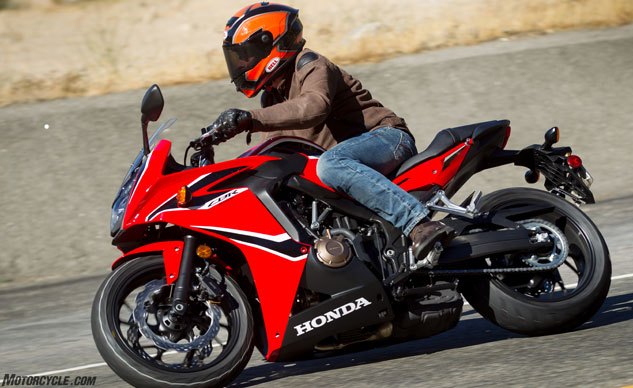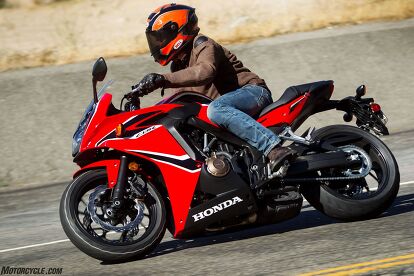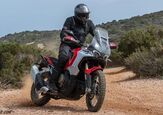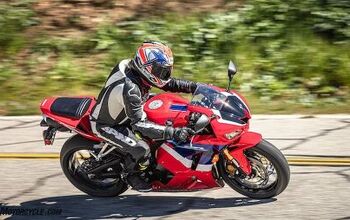2018 Honda CBR650F First Ride Review
Channeling the Original CBR600F for More than 30 Years!
Once upon a time there was the Honda CBR600F, or Hurricane as it was called in the U.S. The magazines tripped all over themselves and I thought maybe I would spend my GI Bill tuition for one, but they were all sold out and I got a left-over 500 Interceptor instead – my first new motorcycle! Just as well, there was less plastic to scrape up.
2018 Honda CBR650F
| Engine | 17.5/20 |
| Suspension/Handling | 13.5/15 |
| Transmission/Clutch | 8.5/10 |
| Brakes | 9.0/10 |
| Instruments/Controls | 4.5/5 |
| Ergonomics/Comfort | 9.0/10 |
| Appearance/Quality | 9.0/10 |
| Desirability | 8.0/10 |
| Value | 7.0/10 |
| Overall Score | 86/100 |
Later, I did get to ride the CBR600F2 when it superseded the original circa 1991, and it was probably one of the best motorcycles of all time. The very last issue of Cycle magazine, as a matter of fact, had the theme World’s Greatest! sportbike on the cover, and the F2 won out over a Kawasaki ZX-11, Ducati 900SS, Honda VFR750F, Yamaha FZR1000 and a Suzuki GSX-R750.
“The best sportbike”, we said, “is the one that offers the most and demands the least. The one that allows you to go fastest easiest, no matter your skill level. The one that’s never a hardship to ride, no matter what kind of riding you’re doing or how hard you’re doing it.” The F2 was $5298 in 1991, and Honda sold 1.2 bazillion of them.
Anyway, the new CBR650F has been around for a couple years now, but this is the first time yours truly has ridden one, and I was flashing back to that old F2 nearly the whole time I was on it. Strange how things progress over a quarter of a century, yet you can still recognize the basic DNA, the way an engine feels between your legs. Bore and stroke have increased a bit to punch the displacement to 649cc from 600. Our dyno at the time said the F2 made 79.7 horsepower at 11,500 rpm; the new 650 made 76.6 at 10,900 when we comparo-tested it here, where it lost out by the narrowest of margins to the Yamaha FZ6R. Cycle’s scales said the old F2 weighed 453.5 pounds, Honda specs the latest CBR650F at 465.2.
For the latest, 2018 version, “revised intake funnels and updated exhaust enhance power output and provide a raucous exhaust growl”, while “revised transmission-gear ratios provide an improved acceleration feel”. It’s “tuned especially for strong acceleration from a standing start and strong midrange roll-on throttle response for real-world street-riding performance”.
I’m down. Then as now, the CBR’s not blazing fast or really amazingly anything, but it does make good useable power at only 4000 rpm, and pulls smoothly all the way to 11K with really no perceptible dips or surges in power anywhere. And it does have a nice growl to it, too, but 76 horsepower is 76 horsepower. And in fact, the dyno that said the old F2 made 79.7 had the ZX-11 at 118 and the FZR1000 at 117, so clearly the horses were larger in 1991.
The biggest and best change for 2018 is the addition of a new Showa Dual Bending Valve fork, an item that went a long way toward propelling sister ship CB1100EX into a win a couple months ago against some stiff competition. The CBR was already a great handling little bike; after a day spent flogging it through some of SoCal’s finest motorcycling roads including a rapid descent of Angeles Crest, I can testify that the new fork gives it really excellent front end feel. Combined with its lightish weight and a rear shock that holds up its end of the conversation, a good gearbox and strong brakes with great feel, this is a motorcycle, that just like that first F2, has great balance. All its systems play perfectly together. The engine never overwhelms the chassis but there’s always smooth power on tap with nary a lurch nor sharp edge, the steering seems perfectly weighted, and sporty but not too sporty ergonomics – with the clip-ons mounted on top of the clamp – let you pay attention to the road and put the CBR right where you want it, apex after apex.
My compadres complained about a little bit of buzz in the handlebars when freeway cruising; 6500 rpm nets about 80 mph in sixth gear. I felt it but, again, it just reminded me of the old F2 – not enough to bother me personally. Though manufacturing tolerances are of course tighter than ever, vibration is one of those things that can vary from bike to bike even of the same model. And variations in the human body perceive it differently. This is a diplomatic way of implying that some of my fellow MOrons are big weenies.
At the end of the day, the new CBR is a great do-it-all bike, with a level of fit and finish befitting a more expensive machine. The problem is it is a more expensive machine compared to its competition. There are now more powerful, sportier bikes in its $8,749 base price range (add $500 for ABS). Both Suzuki’s revised GSX-S 750 and Kawasaki’s new Z900 provide higher performance and lower sticker prices; they’re also bigger and heavier than the CBR, but not by much. And Yamaha’s FZ6R, which we picked over the CBR in 2014, sells for $7799.
The sticker price, I learned when I went to look at that first Hurricane all those years ago, is of course just the beginning of the bargaining process, and isn’t necessarily what you’ll pay. However it stacks up against other bikes in its price range, the CBR650F is a highly refined product, one you can tell Honda’s been at for 31 years now. That can’t be a bad thing.
2018 Honda CBR650F
+ Highs
- Excellent fuelling
- Great ergonomics and light weight
- Highly evolved curve slayer
– Sighs
- A few more hp wouldn’t be a bad thing
- The horn button is still in the wrong place
- The rent is too damn high
2018 Honda CBR650F Specifications | |
|---|---|
| MSRP | $8,749 ($9,249 with ABS) |
| Engine Type | 649cc liquid-cooled inline four-cylinder four-stroke |
| Valve Train | DOHC; 4 valves per cylinder |
| Bore x Stroke | 67.0mm x 46.0mm |
| Compression Ratio | 11.4:1 |
| Induction | Fuel injection; 32mm bore |
| Ignition | Full transistorized |
| Starter | Electric |
| Driveline | Chain final drive; 15T/42T |
| Transmission | Manual 6-speed |
| Clutch | Multiplate wet |
| Front Suspension | 41mm conventional Showa Dual Bending Valve telescopic fork; 4.25 in. travel |
| Rear Suspension | Single shock; 5.04 in. travel |
| Front Brakes | Dual 320mm hydraulic discs in wave pattern w/ two-piston Nissin calipers; ABS Optional |
| Rear Brakes | Single 240mm hydraulic disc in wave pattern w/ single-piston Nissin caliper; ABS Optional |
| Front Tire | 120/70-17 |
| Rear Tire | 180/55-17 |
| Rake (castor angle) | 25º 30′ |
| Trail | 101mm (3.98 in.) |
| Length | 83.1 in. |
| Width | 29.7 in. |
| Height | 45.1 in. |
| Seat Height | 31.9 in. |
| Ground Clearance | 5.1 in. |
| Wheelbase | 57.1 in. |
| Fuel Capacity | 4.6 gal. |
| Curb Weight | 465.2 lbs. (469.6 lbs. with ABS) |
| Color | Red |
More by John Burns











































Comments
Join the conversation
This engine belongs in a CB650 retro. I dont get why Honda dont jump on the retro-train and make a cracking 650 that can compete with street twin and duc scrambler. The basically have the engine and chassis, just have to look back to 70s and redesign.
Let’s see how the sales numbers go. I’m a Honda fan (5 in my garage right now) but they’re slipping big time. The 600RR ceased production because of Euro requirements and so they offer the mid range buyer this???